Bibliometric Evaluation of Energy Efficiency in Agriculture
Abstract
1. Introduction
1.1. Aims and Structure of the Article
1.2. Definition of Energy Efficiency
1.3. Causes and Consequences of the Energy Crisis
- Sustainably improving agricultural productivity to meet the escalating demand.
- Ensuring the preservation of a sustainable natural resource base.
- Mitigating the impact of climate change and intensification of natural hazards.
- Eradicating extreme poverty and reducing inequality.
- Eliminating hunger and addressing all forms of malnutrition.
- Making food systems more efficient, inclusive, and resilient.
- Enhancing income-earning opportunities in rural areas and tackling the root causes of migration.
- Building resilience to protracted crises, disasters, and conflicts.
- Preventing transboundary and emerging threats to agriculture and food systems.
- Addressing the need for coherent and effective national and international governance [43].
1.4. Energy Efficiency in Agriculture
- -
- The adoption of more efficient irrigation methods, such as precision or drip irrigation, can reduce energy consumption.
- -
- Utilizing energy-efficient agricultural machinery, including tractors, harvesters, and pumps.
- -
- Integrating renewable energy sources such as solar panels, wind turbines, and hydropower into agricultural operations can provide clean energy solutions for those working in the agricultural sector.
- -
- Ensuring efficient heating, ventilation, and cooling systems in agricultural buildings (e.g., barns, storage facilities) through the application of energy-efficient technologies. Climate control systems can assist in meeting heating and cooling needs.
- -
- Organic agricultural waste can be utilized to generate renewable energy within the farming economy.
- -
- Implementation of precision agriculture techniques, such as GPS-guided machinery and remote sensing.
- -
- Optimizing the use of fertilizers and pesticides.
- -
- Conducting energy audits to identify areas for improvement.
- -
- Encouraging collaboration among stakeholders.
- -
2. Materials and Methods
2.1. Data Collection
2.2. Method
3. Results
3.1. Global Publication Performance
3.2. Research Performance According to the Countries
3.3. Content and Keyword Analysis of Scientific Works
- -
- Author Keywords, which refer to a set of carefully chosen terms or phrases selected by the authors of a scientific paper. These keywords represent the main themes, concepts, or ideas explored in the research. They act as concise descriptors that encapsulate the core focus of the study, aiding in its discoverability and categorization within scientific databases and literature.
- -
- Keywords Plus, which are generated by bibliometric analysis software based on computer algorithms, or provided by some scientific databases, such as Web of Science. These keywords are designed to complement and expand the original set of Author Keywords.
3.4. Chronology of Trend Topics
3.5. Cooperation Analysis of Scientific Works
3.5.1. Cooperation Patterns Based on Documents of Publications
- -
- Greek collaboration cluster.
- -
- Canadian collaboration cluster.
- -
- Portuguese collaboration cluster.
3.5.2. Cooperation Patterns Based on Countries
4. Discussion
4.1. Characterization of the Research Using SWOT Analysis
4.2. Novelties and Future Research Opportunities
4.3. Further Research Studies and Identifiable Methods
- -
- -
5. Conclusions
Author Contributions
Funding
Data Availability Statement
Conflicts of Interest
References
- Dvoskin, D. Energy-dependent agriculture in Israel. Energy Agric. 2003, 1, 131–139. [Google Scholar] [CrossRef]
- Wysokiński, M.; Domagała, J.; Gromada, A.; Golonko, M.; Trębska, P. Economic and energy efficiency of agriculture. Agric. Econ. 2020, 66, 355–364. [Google Scholar] [CrossRef]
- Engler, N.; Krarti, M. Review of energy efficiency in controlled environment agriculture. Renew. Sustain. Energy Rev. 2021, 141, 110786. [Google Scholar] [CrossRef]
- Kaminsky, J.A.; Faust, K.M. Transitioning from a Human Right to an Infrastructure Service: Water, Wastewater, and Displaced Persons in Germany. Environ. Sci. Tech. 2017, 51, 12081–12088. [Google Scholar] [CrossRef]
- Di Paola, N.; Cosimato, S.; Vona, R. Be resilient today to be sustainable tomorrow: Different perspectives in global supply chains. J. Clean. Prod. 2023, 386, 135674. [Google Scholar] [CrossRef]
- Madani, F.; Parast, M.M. An integrated approach to organizational resilience: A quality perspective. Int. J. Qual. Reliab. Manag. 2023, 40, 192–225. [Google Scholar] [CrossRef]
- Ritchie, H.; Rodés-Guirao, L.; Mathieu, E.; Gerber, M.; Ortiz-Ospina, E.; Hasell, J.; Roser, M. Population Growth. Published online at OurWorldInData.org. 2023. Available online: https://ourworldindata.org/population-growth (accessed on 22 June 2023).
- Muttarak, R.; Wilde, J. (Eds.) The World at 8 Billion; Population Council: New York, NY, USA, 2022; Available online: https://knowledgecommons.popcouncil.org/cgi/viewcontent.cgi?article=1000&context=series_pdr_essays-8-billion (accessed on 26 June 2023).
- United Nations. Our Growing Population, UN Global Issues, 2022, November. Available online: https://www.un.org/en/global-issues/population (accessed on 18 June 2023).
- Chen, J. Rapid urbanization in China: A real challenge to soil protection and food security. Catena 2007, 69, 1–15. [Google Scholar] [CrossRef]
- Masters, W.A.; Djurfeldt, A.A.; De Haan, C.; Hazell, P.; Jayne, T.; Jirström, M.; Reardon, T. Urbanization and farm size in Asia and Africa: Implications for food security and agricultural research. Global Food Sec. 2013, 2, 156–165. [Google Scholar] [CrossRef]
- World-O-Meter. 2023, June. Available online: https://www.worldometers.info/hu (accessed on 15 June 2023).
- Godfray, H.C.J.; Beddington, J.R.; Crute, I.R.; Haddad, L.; Lawrence, D.; Muir, J.F.; Pretty, J.; Robinson, S.; Thomas, S.M.; Toulmin, C. Food Security: The Challenge of Feeding 9 Billion People. Science 2010, 327, 812–818. [Google Scholar] [CrossRef]
- Baldos, U.L.C.; Hertel, T.W. Global food security in 2050: The role of agricultural productivity and climate change. Aust. J. Agric. Res. Econ. 2014, 58, 554–570. [Google Scholar] [CrossRef]
- Guillou, M.; Matheron, G. The World’s Challenge: Feeding 9 Billion People; Springer: London, UK, 2014. [Google Scholar] [CrossRef]
- McKenzie, F.C.; Williams, J. Sustainable food production: Constraints, challenges and choices by 2050. Food Secur. 2015, 7, 221–233. [Google Scholar] [CrossRef]
- Wu, W.B.; Yu, Q.Y.; Verburg, H.P.; You, L.Z.; Yang, P.; Tang, H.J. How Could Agricultural Land Systems Contribute to Raise Food Production Under Global Change? J. Integr. Agric. 2014, 13, 1432–1442. [Google Scholar] [CrossRef]
- Bai, Z.G.; Dent, D.L.; Olsson, L.; Schaepman, M.E. Proxy global assessment of land degradation. Soil Use and Manag. 2008, 24, 223–234. [Google Scholar] [CrossRef]
- Hertwich, E.G.; Peters, G.P. Carbon Footprint of Nations: A Global Trade- Linked Analysis. Environ. Sci. Technol. 2009, 43, 6414–6420. [Google Scholar] [CrossRef]
- Watari, T.; Yokoi, R. International inequality in in-use metal stocks: What it portends for the future. Res. Policy 2021, 70, 101968. [Google Scholar] [CrossRef]
- Hensher, M.; Canny, B.; Zimitat, C.; Campbell, J.; Palmer, A. Health care, overconsumption and uneconomic growth: A conceptual framework. Soc. Sci. Med. 2020, 266, 113420. [Google Scholar] [CrossRef]
- Brown, R.M.; James, M.H. Binge eating, overeating and food addiction: Approaches for examining food overconsumption in laboratory rodents. Prog. Neuro-Psychopharm. Bio. Psych. 2023, 123, 110717. [Google Scholar] [CrossRef]
- Rozi, F.; Santoso, A.B.; Mahendri, I.G.A.P.; Hutapea, R.T.P.; Wamaer, D.; Siagian, V.; Elisabeth, D.A.A.; Sugiono, S.; Handoko, H.; Subagio, H.; et al. Indonesian market demand patterns for food commodity sources of carbohydrates in facing the global food crisis. Heliyon 2023, 9, e16809. [Google Scholar] [CrossRef]
- Tiwari, S.; Dubey, N.K. Nanoencapsulated essential oils as a sustainable approach for control of fungal and mycotoxin contamination of food commodities. Cur. Opin. Food Sci. 2023, 52, 101053. [Google Scholar] [CrossRef]
- Sarkar, A. Minimalonomics: A novel economic model to address environmental sustainability and earth’s carrying capacity. J. Clean. Prod. 2022, 371, 133663. [Google Scholar] [CrossRef]
- Wetzel, K.R.; Wetzel, J.F. Sizing the earth: Recognition of economic carrying capacity. Ecol. Econ. 1995, 12, 13–21. [Google Scholar] [CrossRef]
- Şahin, U. Future of renewable energy consumption in France, Germany, Italy, Spain, Turkey and UK by 2030 using optimized fractional nonlinear grey Bernoulli model. Sustain. Prod. Cons. 2021, 25, 1–14. [Google Scholar] [CrossRef]
- Amil, C.; Yılmazoğlu, M.Z. The importance of hydrogen for energy diversity of Turkey’s energy production: 2030 projection. Int. J. Hydrogen Energy 2022, 47, 19935–19946. [Google Scholar] [CrossRef]
- Spiru, P. Assessment of renewable energy generated by a hybrid system based on wind, hydro, solar, and biomass sources for decarbonizing the energy sector and achieving a sustainable energy transition. Energy Rep. 2023, 9, 167–174. [Google Scholar] [CrossRef]
- Ni, D.; Jiwen Song, L.; Zheng, X.; Zhu, J.; Zhang, M.; Xu, L. Extending a helping hand: How receiving gratitude makes a difference in employee performance during a crisis. J. Bus. Res. 2022, 149, 967–982. [Google Scholar] [CrossRef]
- Roth, M.; Franke, G.; Rinderknecht, S. Optimal component sizing and operational optimisation of a mobile energy system for decentralised electricity supply. Smart Energy 2023, 11, 100108. [Google Scholar] [CrossRef]
- International Energy Agency (IEA). World Energy Outlook (WEO). 2022. Available online: https://www.iea.org/reports/world-energy-investment-2023 (accessed on 18 June 2023).
- Haimes, Y.Y. Sustainable development: A holistic approach to natural resource management. IEEE Trans. Syst. Man Cybern. 1992, 22, 413–417. [Google Scholar] [CrossRef]
- Naveh, Z. What is holistic landscape ecology? A conceptual introduction. Landsc. Urban Plan. 2000, 50, 7–26. [Google Scholar] [CrossRef]
- Directive 2012/27/EU of the European Parliament and of the Council: Article 2—Energy efficiency. Available online: https://eur-lex.europa.eu/legal-content/EN/TXT/PDF/?uri=CELEX:02012L0027-20210101 (accessed on 23 June 2023).
- Sebestyénné, S.T. Energiafelhasználás és energiahatékonyság. Energiagazdálkodás 2013, 54, 2–5. [Google Scholar]
- Moldicz, C. Törésvonalak Európában—Közép-Európa helyzete az új világrendben. Eurázsia Szle. 2021, 1, 62–79. [Google Scholar]
- Diana-Elena, V.C.; Lucian, B.; Alexandra, H. Considerations Upon the Effects of Covid-19 Pandemic on the Romanian Economic Environment. Stud. Bus. Econ. 2022, 17, 272–289. [Google Scholar] [CrossRef]
- Szabó, Z.T.; Forgó, G.; Alpek, B.L. A COVID-19 Világjárvány, Valamint az Orosz–Ukrán Konfliktus Hatásai az Ellátási Láncokra és az Energiaellátás Biztonságára, 210–240. In Geopolitika, Pénzügy és Gazdaság a Felemelkedő Eurázsiában; Tárik, M., Veres, S., Eds.; Neumann János Egyetem: Budapest, Hungary, 2022. [Google Scholar]
- Karsai, G. GKI Gazdaságkutató Zrt.: Idén 0,5 százalékos visszaesés és 19 százalékos infláció várható. Külgazd 2023, 67, 32–52. [Google Scholar] [CrossRef]
- The State of Food and Agriculture 2022: What Is Agricultural Automation? Available online: https://www.fao.org/3/cb9479en/online/sofa-2022/agricultural-automation-technological-evolution.html (accessed on 18 May 2023).
- Santos Valle, S.; Kienzle, J. Agriculture 4.0—Agricultural robotics and automated equipment for sustainable crop production. Integr. Crop Manag. 2020, 24, 1–25. Available online: https://www.fao.org/3/cb2186en/CB2186EN.pdf (accessed on 27 May 2023).
- The Future of Food and Agriculture—Trends and challenges. Food and Agriculture Organization of the United Nations, Rome. 2017. Available online: https://www.fao.org/3/i6583e/i6583e.pdf (accessed on 12 June 2023).
- Our World in Data. Primary Energy Consumption by World Region. Available online: https://ourworldindata.org/grapher/primary-energy-consumption-by-region (accessed on 27 May 2023).
- Enerdata. Total Energy Consumption. Available online: https://yearbook.enerdata.net/total-energy/world-consumption-statistics.html (accessed on 28 May 2023).
- Wang, M.; Xie, L. Households’ participation in energy transition and sustained use of clean energy: Evidence from China’s clean heating program. China Econ. Rev. 2023, 80, 102005. [Google Scholar] [CrossRef]
- Szeberényi, A.; Bakos, I.M. Examining the progress of European Union and Hungary in the Aspect of Sustainable Development Goals. In Full Texts Book, Proceedings of the Cukurova 9th International Scientific Researches Conference, Adana, Turkey, 9–11 October 2022; Cagri, Ü., Merve, K., Eds.; IKSAD Publishing: Ankara, Turkey, 2022; Volume 2, pp. 1423–1433. [Google Scholar]
- Svazas, M.; Navickas, V.; Paskevicius, R.; Bilan, Y.; Vasa, L. Renewable energy versus energy security: The impact of innovation on the economy. Rynek Energii 2023, 164, 60–71. [Google Scholar]
- Bin-Nashwan, S.A.; Hassan, M.K.; Muneeza, A. Russia–Ukraine conflict: 2030 Agenda for SDGs hangs in the balance. Int. J. Ethics Syst. 2022. ahead-of-print. [Google Scholar] [CrossRef]
- Bakos, I.M.; Szeberényi, A. The tourism and environmentally friendly aspects of the short food supply chains. In Sustainable Development Sztravropol; Vladimir, T., Ed.; Sequoia: Menlo Park, CA, USA, 2017; pp. 5–11. [Google Scholar]
- Nchasi, G.; Mwasha, C.; Shaban, M.M.; Rwegasira, R.; Mallilah, B.; Chesco, J.; Volkova, A.; Mahmoud, A. Ukraine’s triple emergency: Food crisis amid conflicts and COVID-19 pandemic. Health Sci. Rep. 2022, 5, 1–4. [Google Scholar] [CrossRef]
- Lin, F.; Li, X.C.; Jia, N.Y.; Feng, F.; Huang, H.; Huang, J.X.; Fan, S.G.; Ciais, P.; Song, X.P. The impact of Russia-Ukraine conflict on global food security. Glob. Food Sec.-Agri. Policy Econ. Environ. 2023, 36, 100661. [Google Scholar] [CrossRef]
- Gandhi, H.H.; Hoex, B.; Hallam, B.J. Strategic investment risks threatening India’s renewable energy ambition. Energy Strategy Rev. 2022, 43, 100921. [Google Scholar] [CrossRef]
- Soutar, I.; Devine-Wright, P.; Rohse, M.; Walker, C.; Gooding, L.; Devine-Wright, H.; Kay, I. Constructing practices of engagement with users and communities: Comparing emergent state-led smart local energy systems. Energy Policy 2022, 171, 113279. [Google Scholar] [CrossRef]
- Bozsik, N.; Szeberényi, A.; Bozsik, N. Examination of the Hungarian Electricity Industry Structure with Special Regard to Renewables. Energies 2023, 16, 3826. [Google Scholar] [CrossRef]
- Rokicki, T.; Jadczak, R.; Kucharski, A.; Bórawski, P.; Szeberényi, A.; Perkowska, A. Changes in Energy Consumption and Energy Intensity in EU Countries as a Result of the COVID-19 Pandemic by Sector and Area Economy. Energies 2022, 15, 6243. [Google Scholar] [CrossRef]
- Engel, J. 2022: Scorecard Ranks Countries on Energy Efficiency: Who’s Ahead of 10th Place U.S? Renewable Energy World. 2022. Available online: https://www.renewableenergyworld.com/energy-efficiency/scorecard-ranks-countries-on-energy-efficiency%e2%81%a0-whos-ahead-of-10th-place-u-s/ (accessed on 5 June 2023).
- Eurostat. Energy consumption in the EU. 2023. Available online: https://ec.europa.eu/eurostat/databrowser/view/nrg_bal_s/default/table?lang=en (accessed on 17 June 2023).
- Zhu, N.; Streimikis, J.; Yu, Z.; Balezentis, T. Energy-sustainable agriculture in the European Union member states: Overall productivity growth and structural efficiency. Socio-Econ. Plan. Sci. 2023, 87, 101520. [Google Scholar] [CrossRef]
- Chen, C. CiteSpace II: Detecting and visualizing emerging trends and transient patterns in scientific literature. J. Am. Soc. Inf. Sci. Tech. 2006, 57, 359–377. [Google Scholar] [CrossRef]
- Van Eck, N.J.; Waltman, L. Software Survey: VOSviewer, a Computer Program for Bibliometric Mapping. Scientometrics 2010, 84, 523–538. [Google Scholar] [CrossRef]
- Rodrìguez-Soler, R.; Uribe-Toril, J.; De Pablo Valenciano, J. Worldwide trends in the scientific production on rural depopulation, a bibliometric analysis using bibliometrix R-tool. Land Use Policy 2020, 97, 104787. [Google Scholar] [CrossRef]
- Mayer-Schönberger, V.; Cukier, K. Big Data: Forradalmi Módszer, Amely Megváltoztatja Munkánkat, Gondolkodásunkat és Egész Életünket; HVG Kiadó Zrt: Budapest, Hungary, 2018. [Google Scholar]
- Dobák, M.; Antal, Z. Vezetés és Szervezés: Szervezetek Kialakítása és Működtetése; Akadémiai Kiadó: Budapest, Hungary, 2015. [Google Scholar]
- Pozdnyakov, A.V.; Semenova, K.A.; Fuzella, T. Energy-based measuring of ecological and economic effectiveness of agroecosystems. In IOP Conference Series: Earth and Environmental Science, Proceedings of the 5th International Summer School for Students and Young Scientists “Natural and Human Environment of Arctic and Alpine Areas: Relief, Soils, Permafrost, Glaciers, Biota Life Style of Native Ethnic Groups in a Rapidly Changing Climate”, Tomsk, Russia, 7–21 July 2018; IOP Publishing: Bristol, UK, 2019; Volume 232, p. 012009. [Google Scholar] [CrossRef]
- Hercher-Pasteur, J.; Loiseau, E.; Sinfort, C.; Hélias, A. Energetic assessment of the agricultural production system. A review. Agron. Sustain. Dev. 2020, 40, 29. [Google Scholar] [CrossRef]
- Koseleva, N.; Ropaite, G. Big Data in Building Energy Efficiency: Understanding of Big Data and Main Challenges. Procedia Eng. 2017, 172, 544–549. [Google Scholar] [CrossRef]
- Baesens, B. Analytics in a Big Data World: The Essential Guide to Data Science and its Applications; John Wiley & Sons: Hoboken, NJ, USA, 2014; Available online: https://lirias.kuleuven.be/1834701?limo=0 (accessed on 12 June 2023).
- Barrile, V.; Simonetti, S.; Citroni, R.; Fotia, A.; Bilotta, G. Experimenting Agriculture 4.0 with Sensors: A Data Fusion Approach between Remote Sensing, UAVs and Self-Driving Tractors. Sensors 2022, 22, 7910. [Google Scholar] [CrossRef]
- Abbasi, R.; Martinez, P.; Ahmad, R. The digitization of agricultural industry—A systematic literature review on agriculture 4.0. Smart Agric. Technol. 2022, 2, 100042. [Google Scholar] [CrossRef]
- Diljun, G.M.; Sinha, V.S.P.; Chamola, M.; Singh, P.; Mishra, A.; Dobhal, R. Estimation and comparison of energy input–output and efficiency indices for rice–wheat agroecosystems of Doon Valley, India. Current Sci. 2022, 123, 881–886. [Google Scholar] [CrossRef]
- Ashraf, M.N.; Mahmood, M.H.; Sultan, M.; Shamshiri, R.R.; Ibrahim, S.M. Investigation of Energy Consumption and Associated CO2 Emissions for Wheat–Rice Crop Rotation Farming. Energies 2021, 14, 5094. [Google Scholar] [CrossRef]
- Kosemani, B.S.; Bamgboye, A.I. Energy input-output analysis of rice production in Nigeria. Energy 2020, 207, 118258. [Google Scholar] [CrossRef]
- Baran, M.F.; Oguz, H.I.; Gokdogan, O. Determination of Energy Input-Output Analysis in Plum (Prunus domestica L.) Production. Erwerbs-Obstbau 2017, 59, 331–335. [Google Scholar] [CrossRef]
- Yilmaz, H.; Aydin, B. Comparative Input-Output Energy Analysis of Citrus Production in Turkey: Case of Adana Province. Erwerbs-Obstbau 2020, 62, 29–36. [Google Scholar] [CrossRef]
- Ali, Q.; Abbas, A.; Khan, M.T.I.; Bagadeem, S.; Alotaibi, B.A.; Tariq, M.; Traore, A. Sustainable Agriculture through Reduced Emission and Energy Efficiency: Estimation of Input–Output Energy and GHG Emission under Tunnel Cultivation of Tomato. Agronomy 2022, 12, 1730. [Google Scholar] [CrossRef]
- Yılmaz, A.; Bayav, A. Determination of Energy Efficiency in Almond Production According to Variety: A Case Study in Turkey. Erwerbs-Obstbau 2022, 65, 971–979. [Google Scholar] [CrossRef]
- Bojacá, C.R.; Casilimas, H.A.; Gil, R.; Schrevens, E. Extending the input–output energy balance methodology in agriculture through cluster analysis. Energy 2012, 47, 465–470. [Google Scholar] [CrossRef]
- Harun, M.; Ahmad, S.A.; Sulaiman, N.; Tria, D. Sectoral Energy-CO2 emissions using an environmental input-output framework. Int. J. Bus. Soc. 2021, 22, 1066–1075. [Google Scholar] [CrossRef]
- Liu, Y.; Hu, Y.; Su, M.; Meng, F.; Dang, Z.; Lu, G. Multiregional input-output analysis for energy-water nexus: A case study of Pearl River Delta urban agglomeration. J. Clean. Prod. 2020, 262, 121255. [Google Scholar] [CrossRef]
- Yu, Y.; Jiang, T.; Li, S.; Li, X.; Gao, D. Energy-related CO2 emissions and structural emissions’ reduction in China’s agriculture: An input–output perspective. J. Clean. Prod. 2020, 276, 124169. [Google Scholar] [CrossRef]
- Abbas, A.; Zhao, C.; Waseem, M.; Ahmed Khan, K.; Ahmad, R. Analysis of Energy Input–Output of Farms and Assessment of Greenhouse Gas Emissions: A Case Study of Cotton Growers. Front. Environ. Sci. 2022, 9, 826838. [Google Scholar] [CrossRef]
- Liu, X.; Xiong, R.; Guo, P.; Nie, L.; Shi, Q.; Li, W.; Cui, J. Virtual Water Flow Pattern in the Yellow River Basin, China: An Analysis Based on a Multiregional Input–Output Model. Int. J. Environ. Res. Public Health 2022, 19, 7345. [Google Scholar] [CrossRef] [PubMed]
- Wang, X.; Klemeš, J.J.; Wang, Y.; Dong, X.; Wei, H.; Xu, Z.; Varbanov, P.S. Water-Energy-Carbon Emissions nexus analysis of China: An environmental input-output model-based approach. Appl. Energy 2020, 261, 114431. [Google Scholar] [CrossRef]
- Xu, W.; Xie, Y.; Cai, Y.; Ji, L.; Wang, B.; Yang, Z. Environmentally-extended input-output and ecological network analysis for Energy-Water-CO2 metabolic system in China. Sci. Total Environ. 2021, 758, 143931. [Google Scholar] [CrossRef] [PubMed]
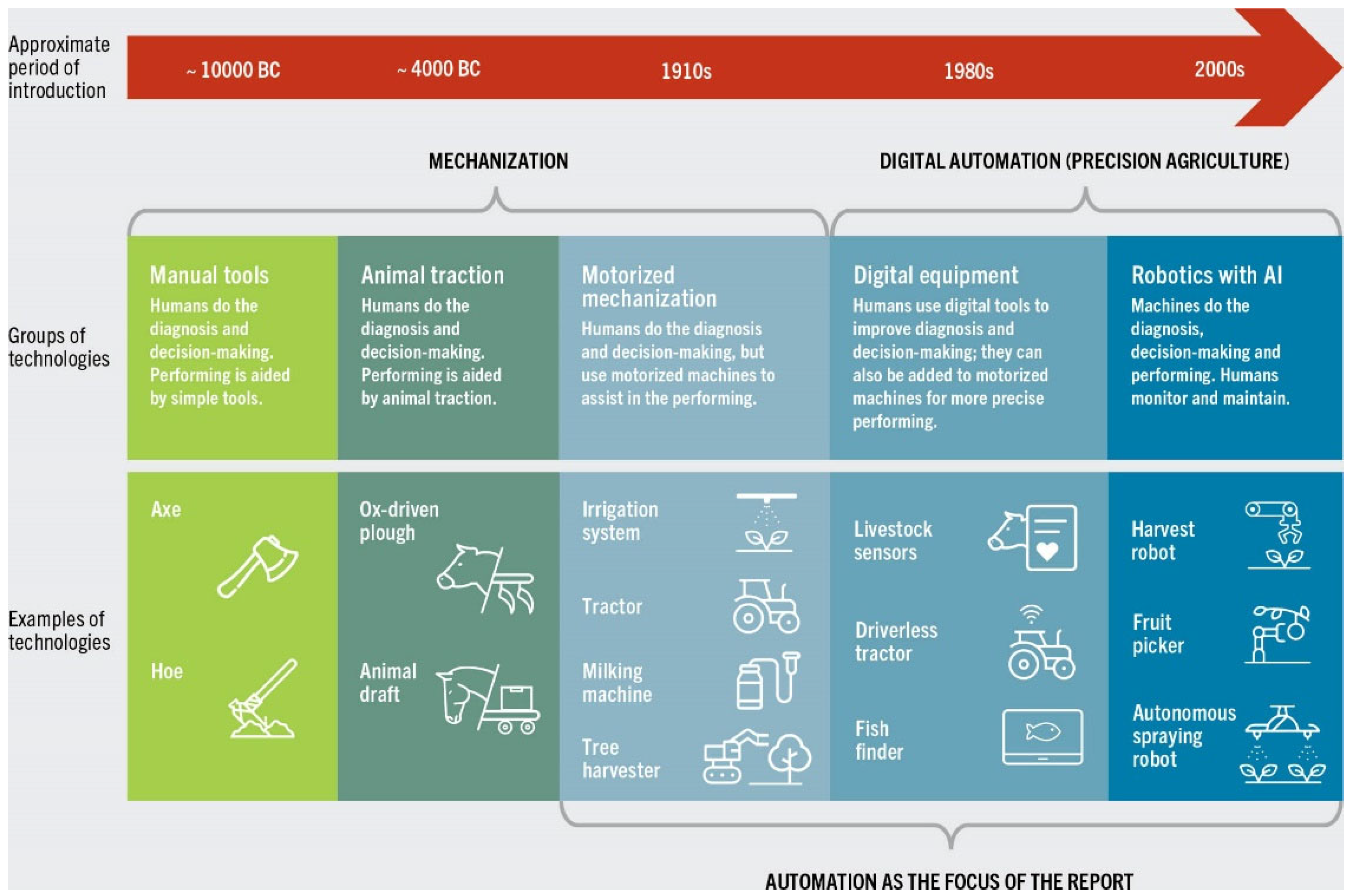
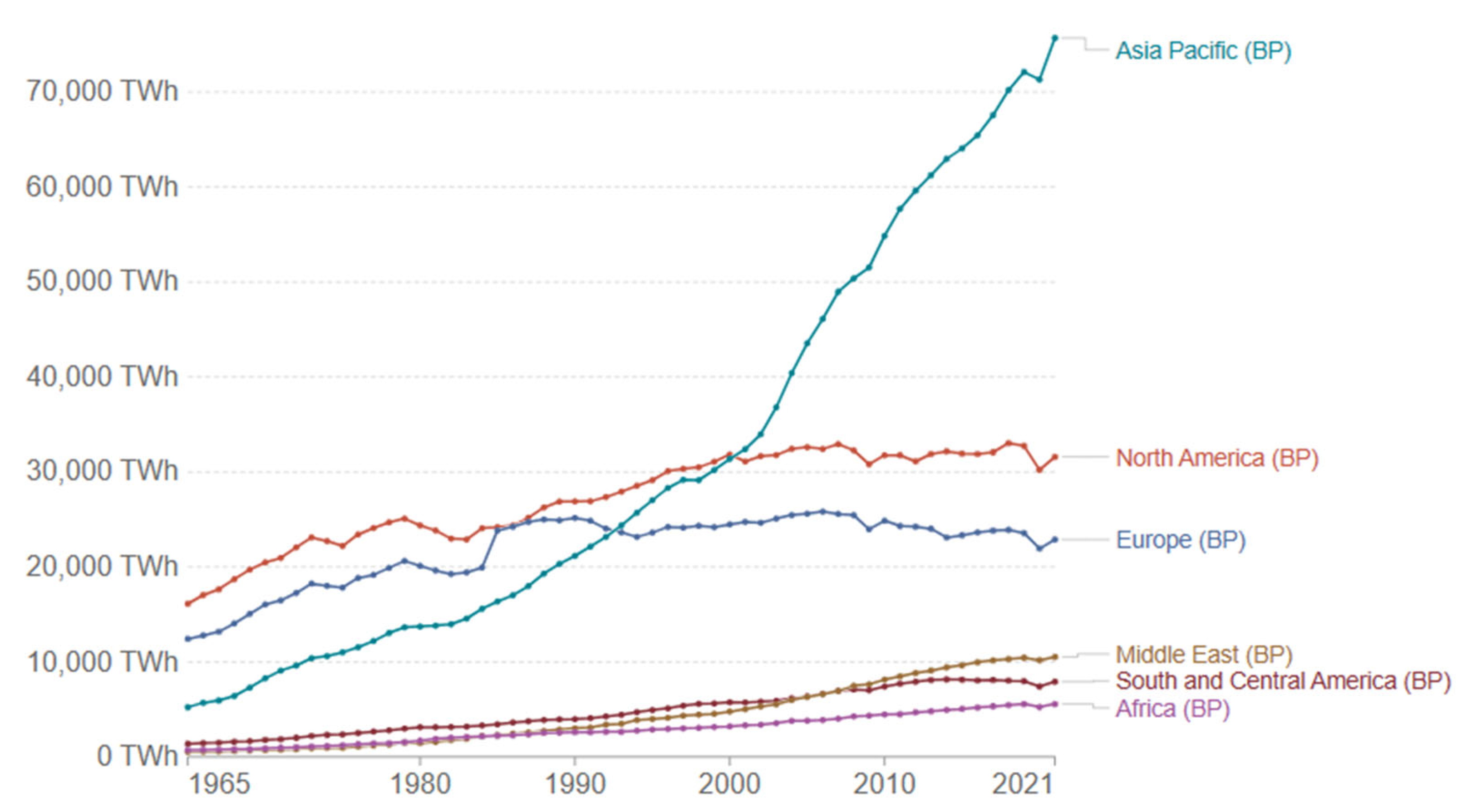

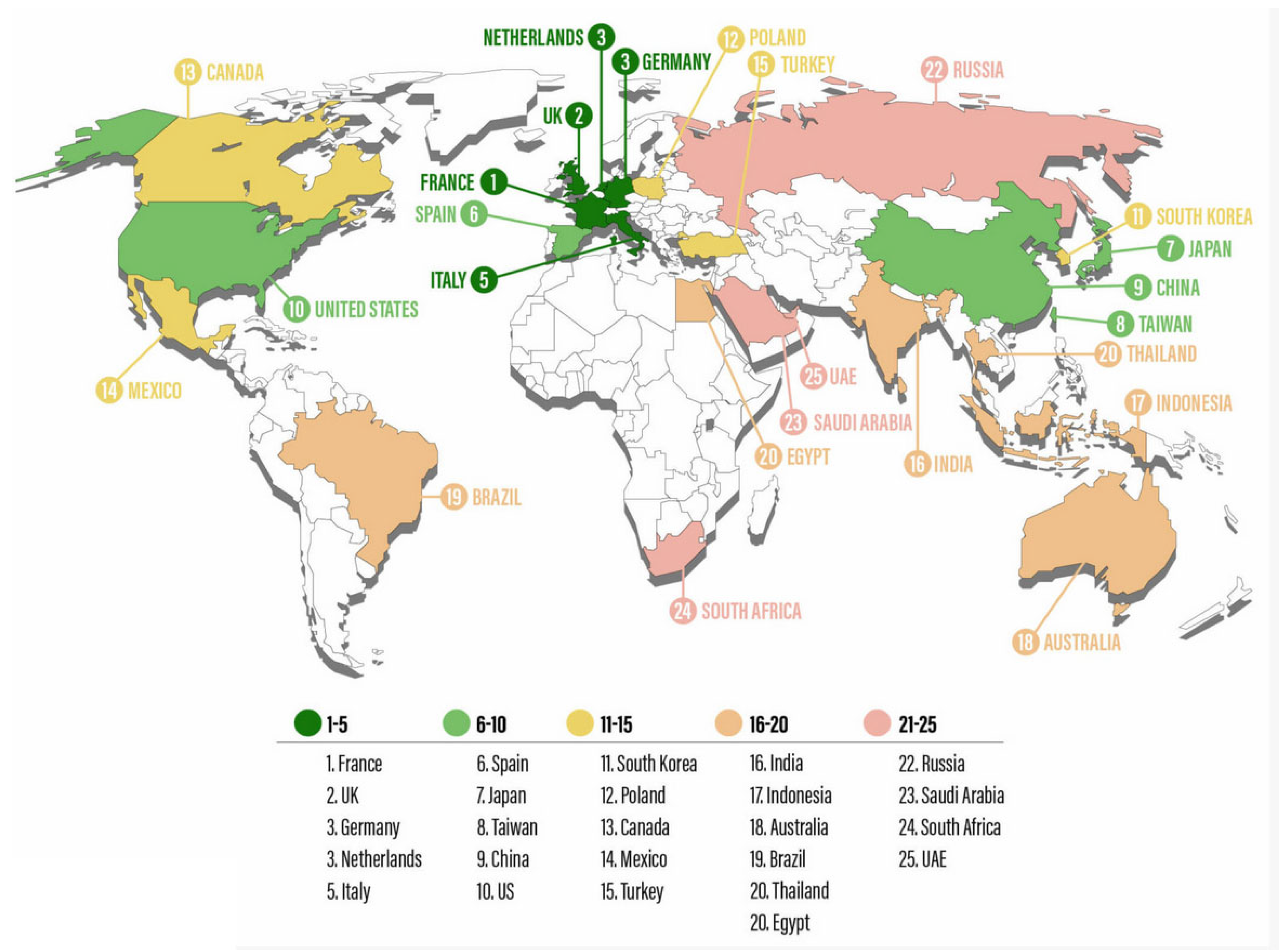
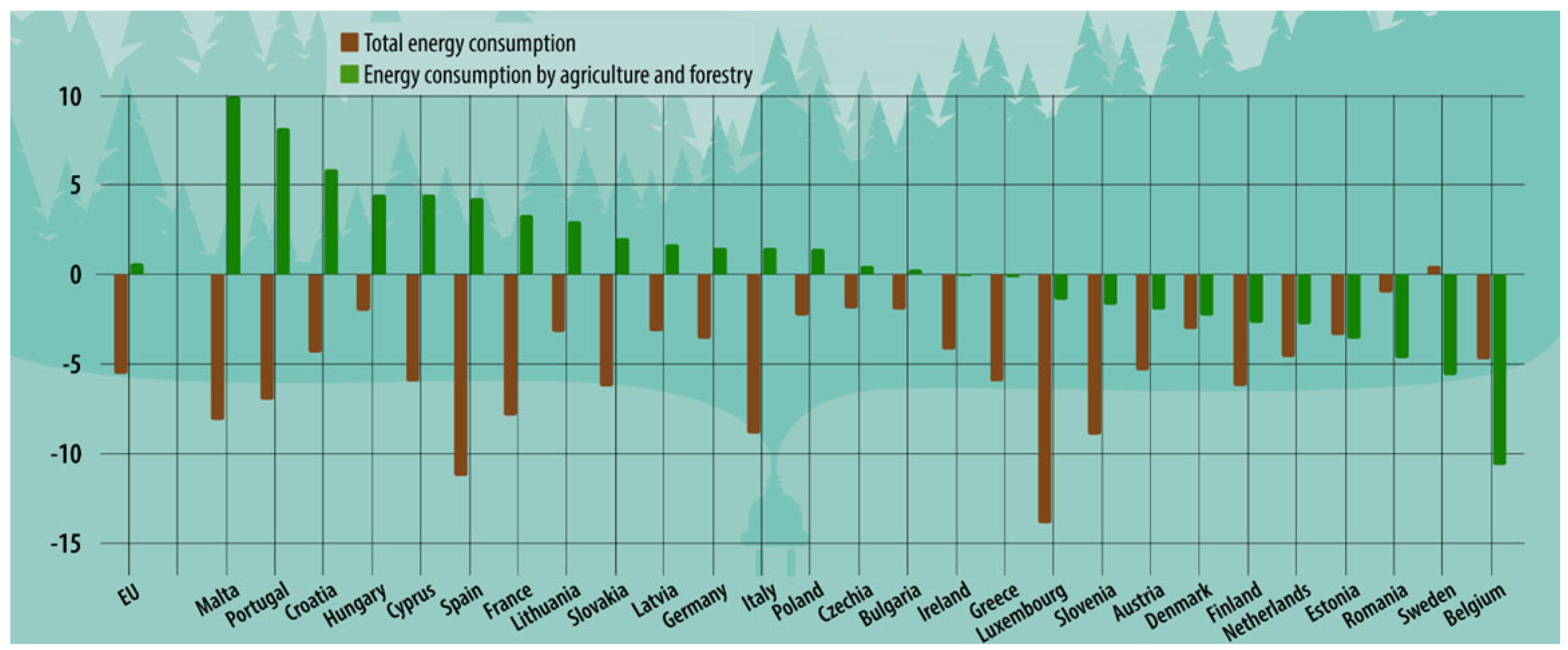
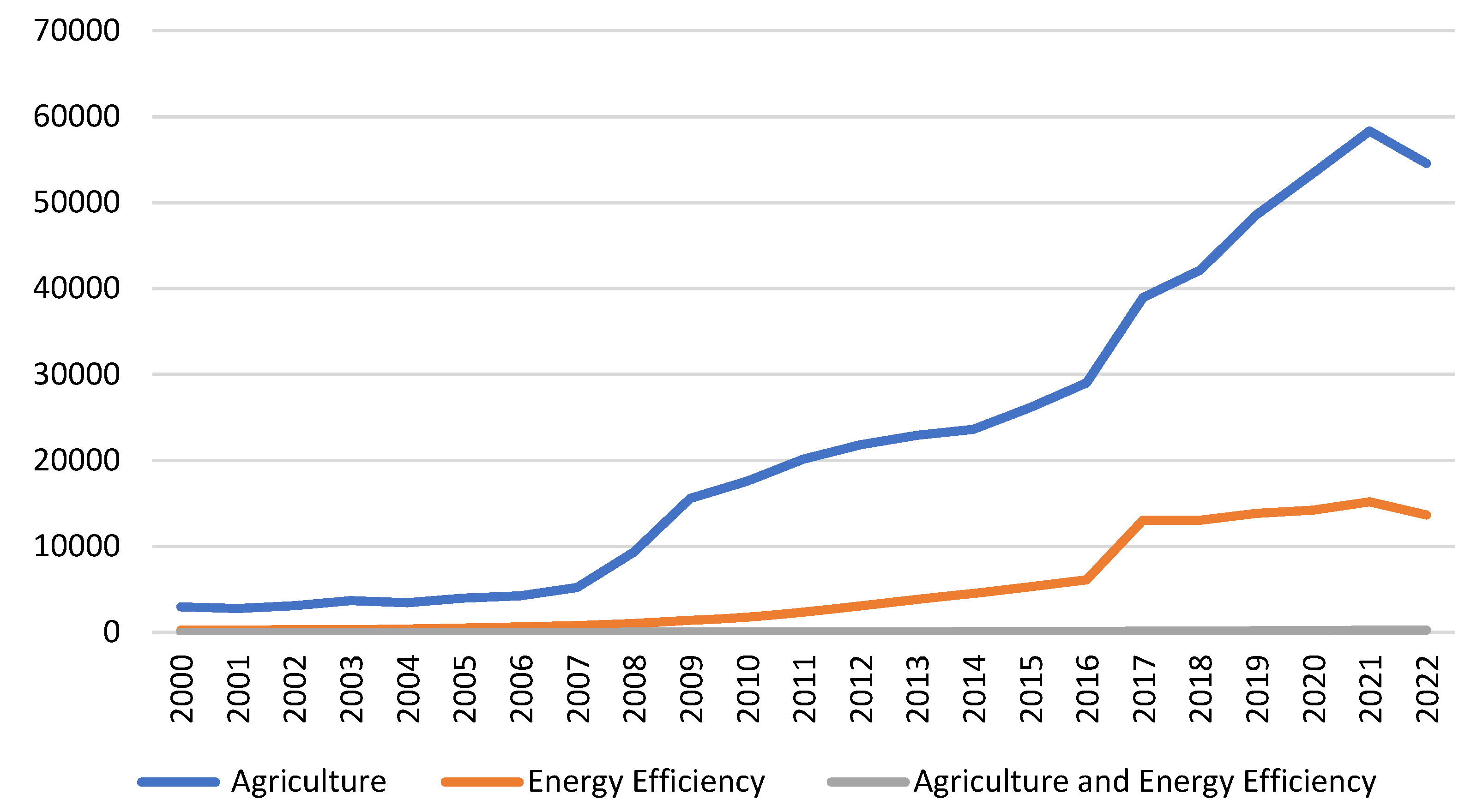
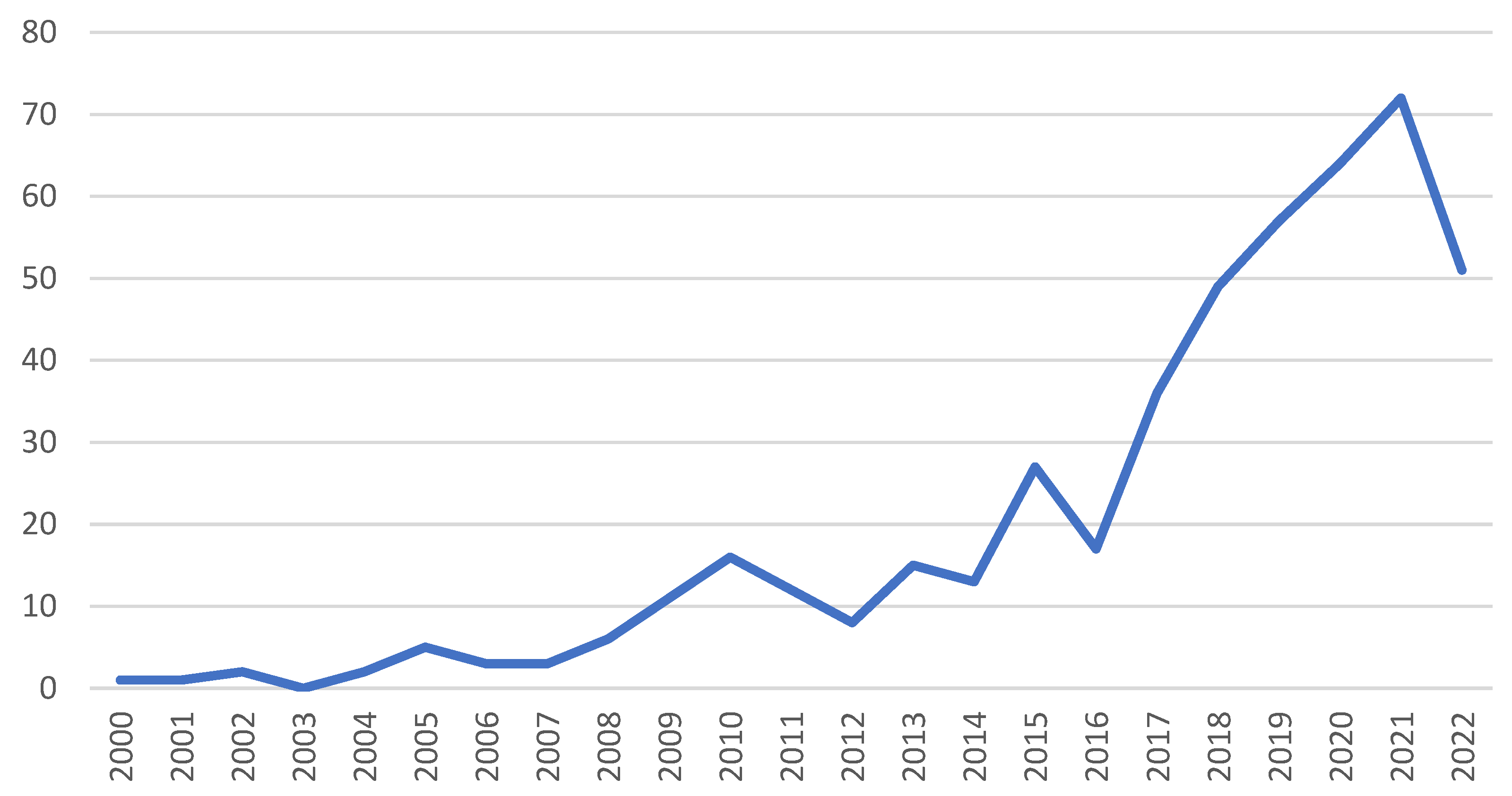

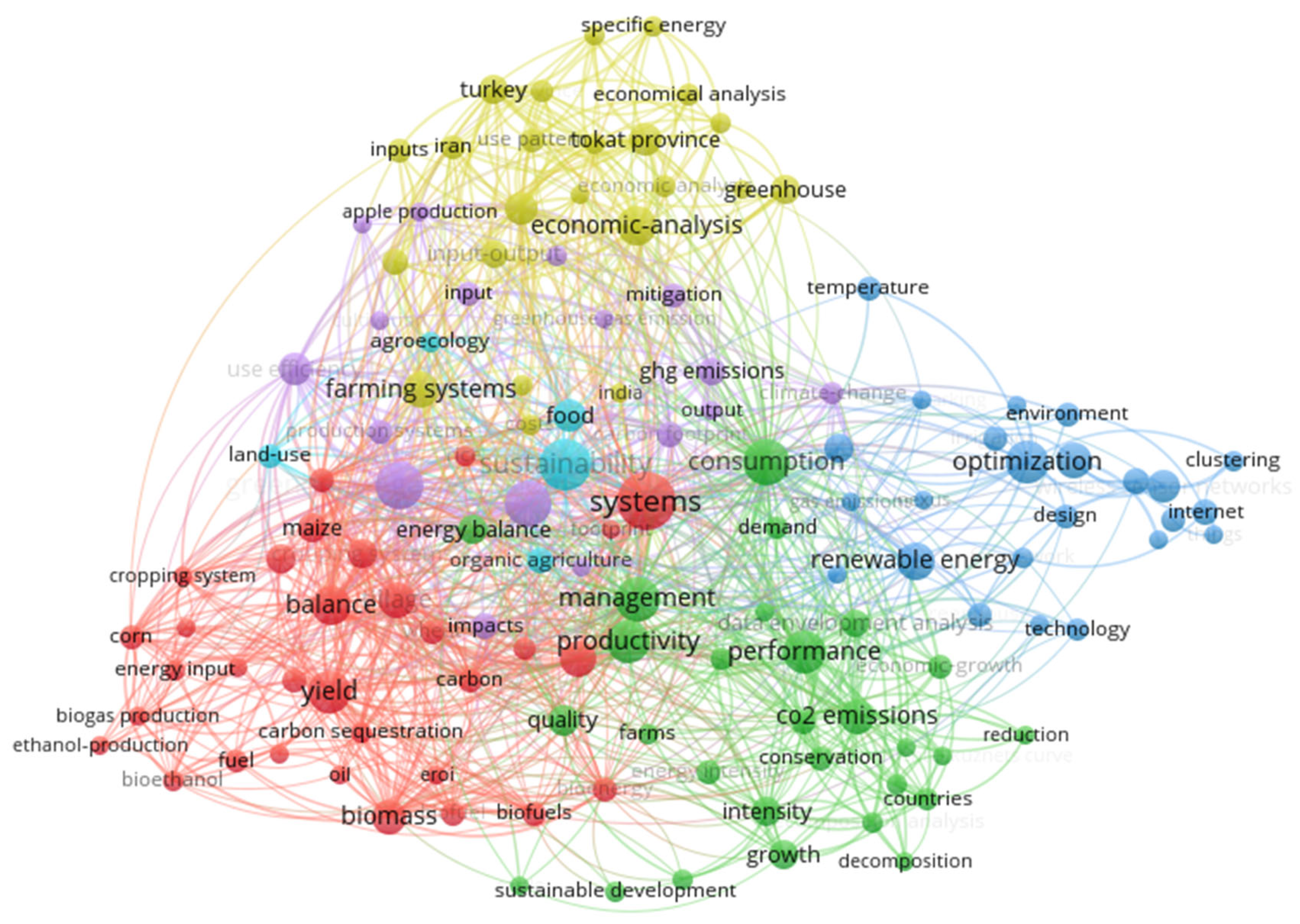
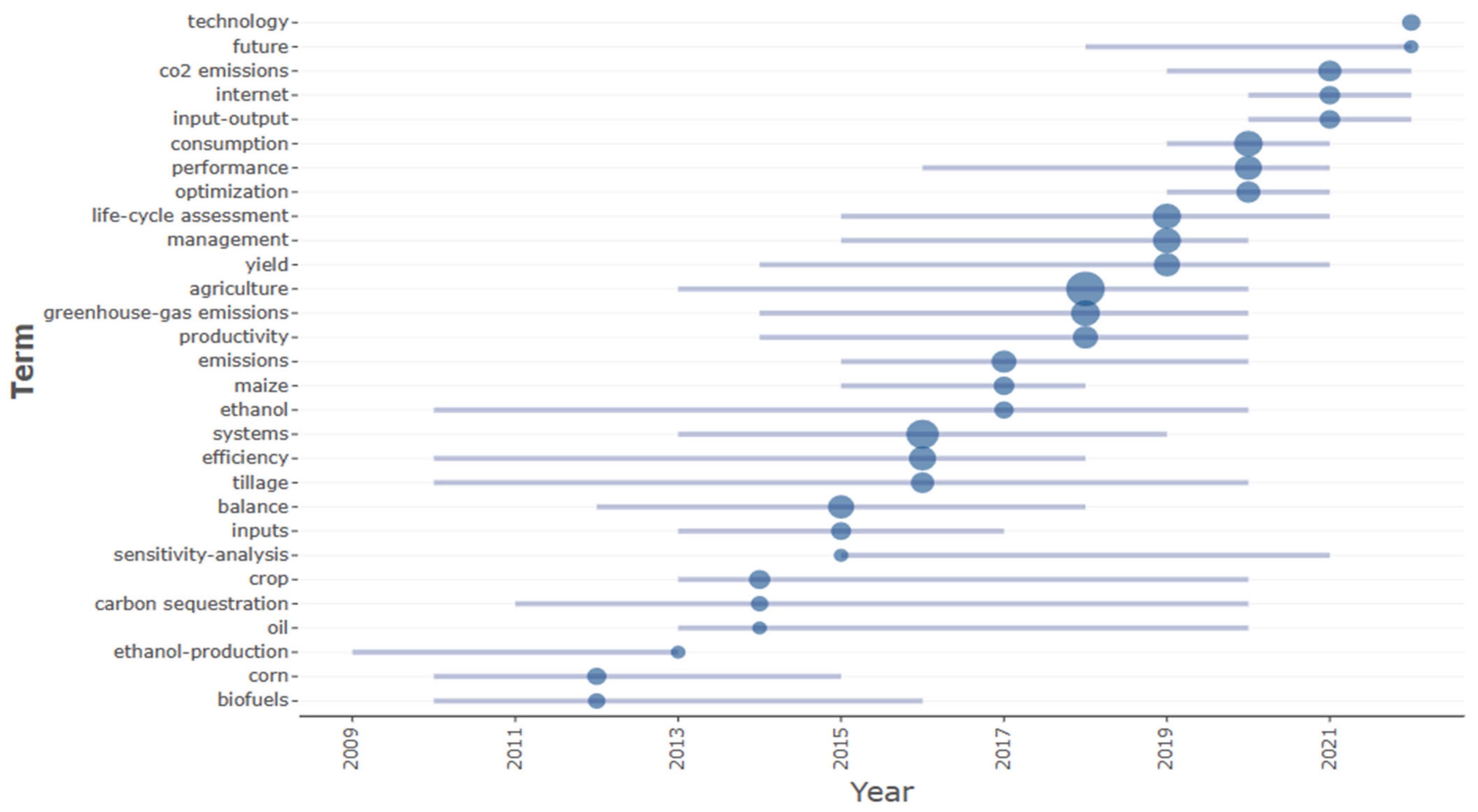
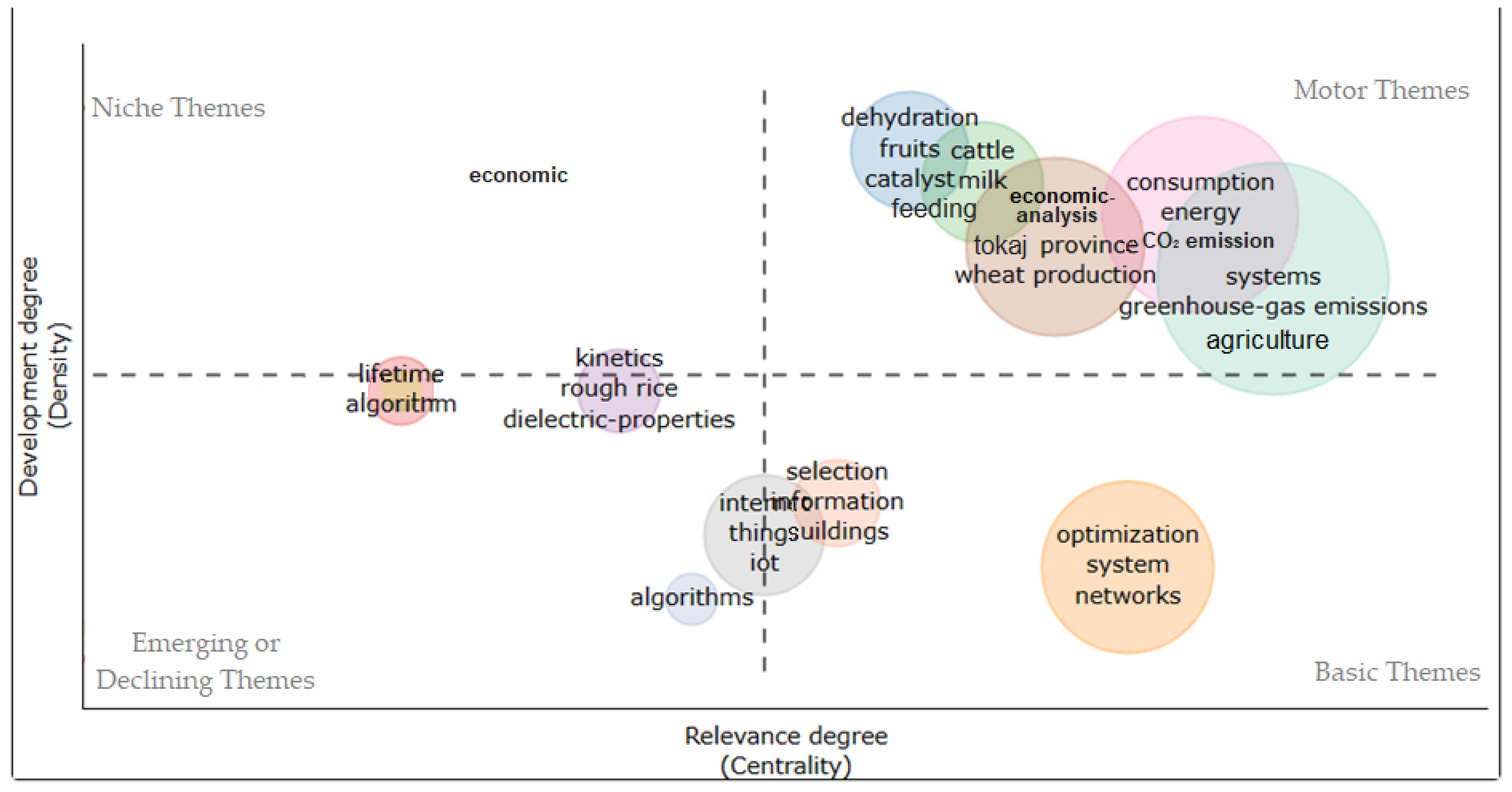

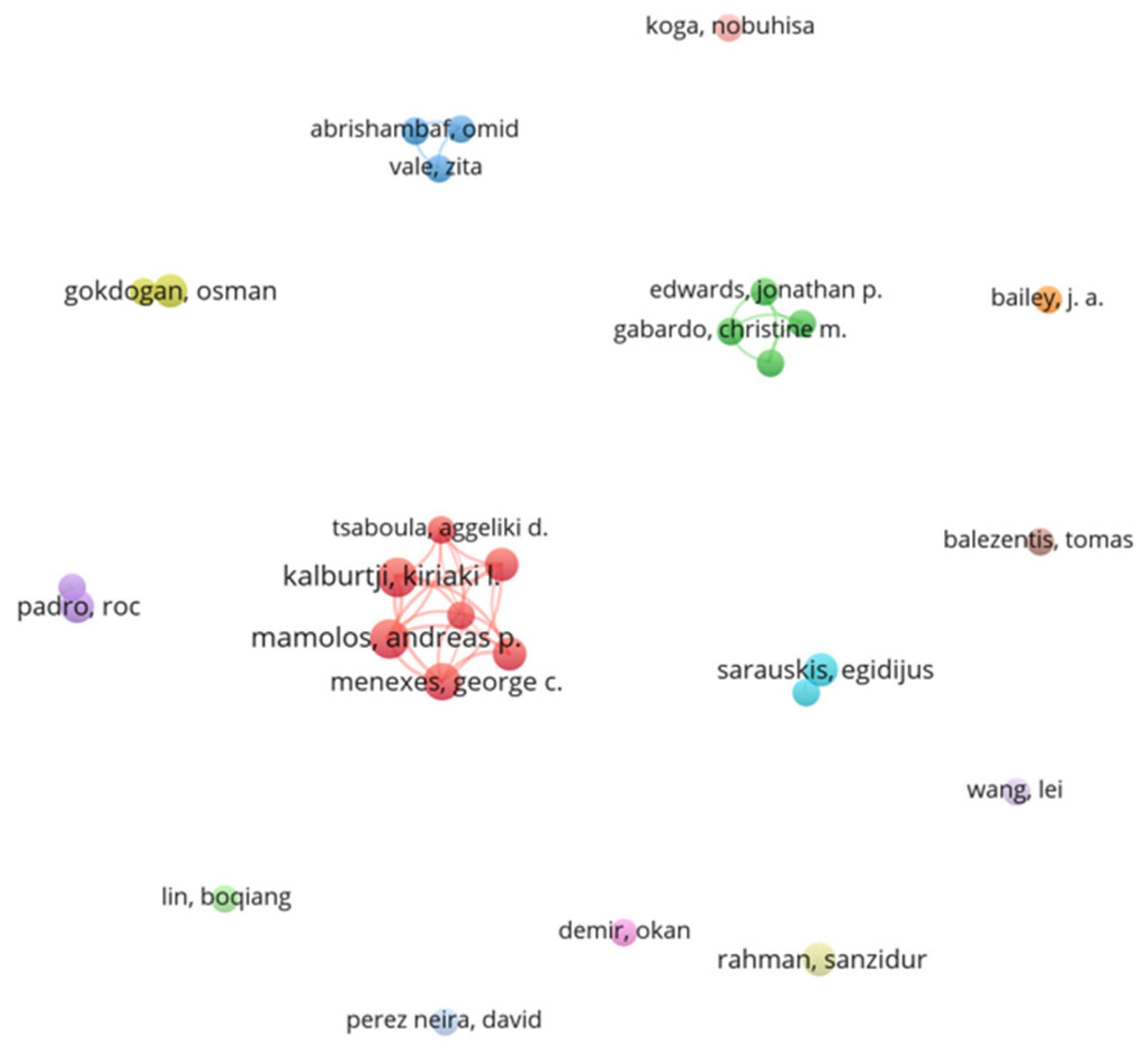

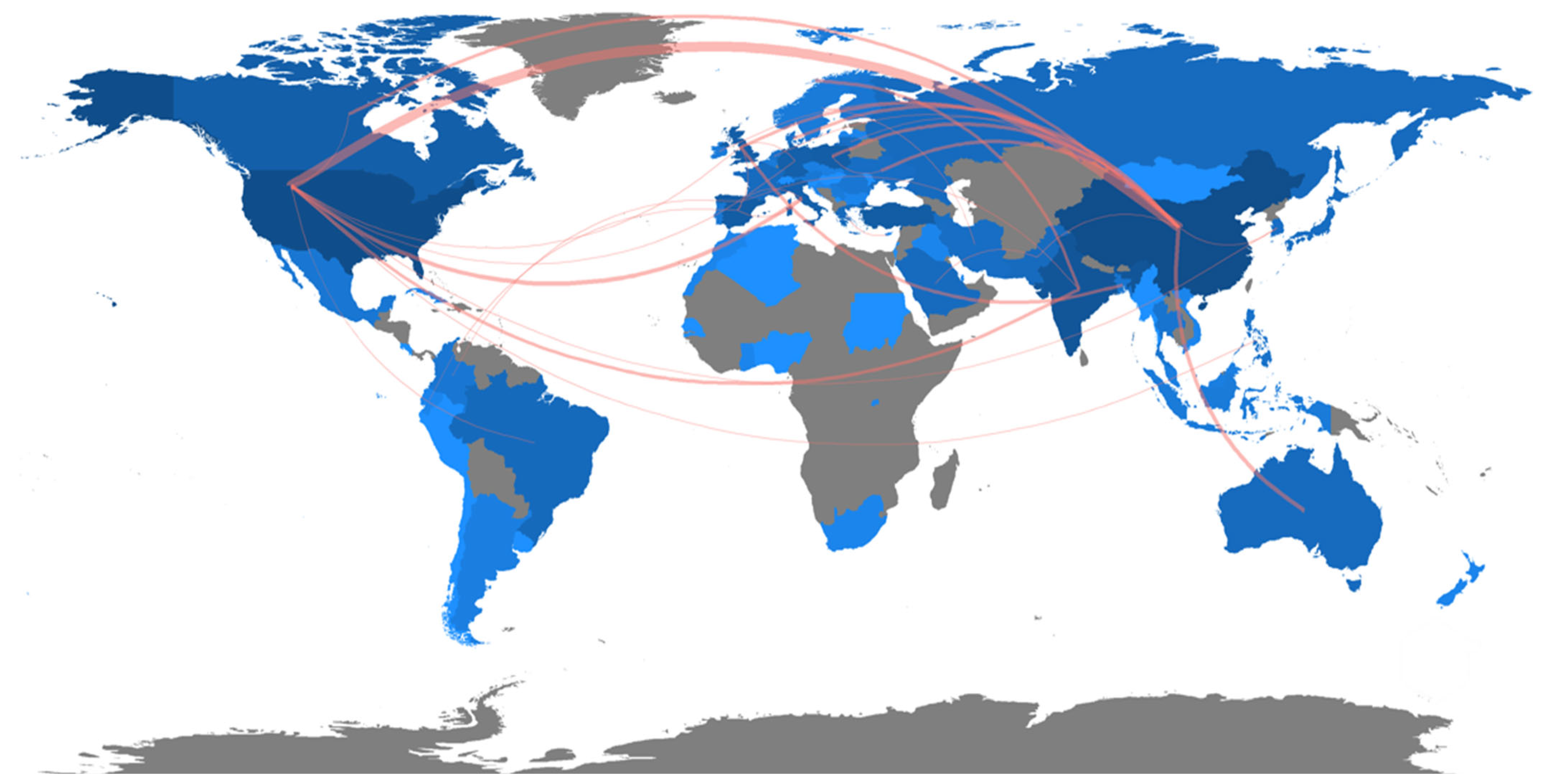
| Ranking | Country | Absolute Frequency |
|---|---|---|
| 1 | China | 7179 |
| 2 | USA | 4541 |
| 3 | India | 1512 |
| 4 | Italy | 1178 |
| 5 | Germany | 1161 |
| 6 | Iran | 1116 |
| 7 | Australia | 1109 |
| 8 | Brazil | 1039 |
| 9 | Canada | 985 |
| 10 | Japan | 863 |
| 11 | Pakistan | 800 |
| 12 | England | 793 |
| 13 | South Korea | 769 |
| 14 | Spain | 767 |
| 15 | Sweden | 591 |
| 16 | Poland | 580 |
| 17 | France | 557 |
| 18 | Saudi Arabia | 541 |
| 19 | Egypt | 533 |
| 20 | Netherlands | 498 |
| 21 | Turkey | 493 |
| 22 | Russia | 387 |
| 23 | Malaysia | 386 |
| 24 | Thailand | 379 |
| 25 | Denmark | 346 |
| 51 | Hungary | 118 |
| Clusters | Authors | Institutes |
|---|---|---|
| Cluster 1 (Greek collaboration cluster) |
| Laboratory of Pesticide Residues, Department of Pesticides Control and Phytopharmacy, Benaki Phytopathological Institute |
|
| |
|
| |
|
| |
|
| |
|
| |
| Faculty of Agriculture, Laboratory of Agricultural Engineering, Aristotle University of Thessaloniki | |
| Cluster 2 (Canadian collaboration cluster) | Edwards, Jonathan P | Department of Mechanical and Industrial Engineering, University of Toronto |
| Gabardo, Christine M | Department of Mechanical and Industrial Engineering, University of Toronto | |
| Sargent, Edward H | Department of Electrical and Computer Engineering, University of Toronto | |
| Sinton, David | Department of Mechanical Engineering, University of Victoria | |
| Cluster 3 (Portuguese collaboration cluster) | Abrishambaf, Omid | Polytechnic of Porto, |
| Faria, Pedro | Polytechnic of Porto, | |
| Vale, Zita | Polytechnic of Porto |
Disclaimer/Publisher’s Note: The statements, opinions and data contained in all publications are solely those of the individual author(s) and contributor(s) and not of MDPI and/or the editor(s). MDPI and/or the editor(s) disclaim responsibility for any injury to people or property resulting from any ideas, methods, instructions or products referred to in the content. |
© 2023 by the authors. Licensee MDPI, Basel, Switzerland. This article is an open access article distributed under the terms and conditions of the Creative Commons Attribution (CC BY) license (https://creativecommons.org/licenses/by/4.0/).
Share and Cite
Benedek, A.; Rokicki, T.; Szeberényi, A. Bibliometric Evaluation of Energy Efficiency in Agriculture. Energies 2023, 16, 5942. https://doi.org/10.3390/en16165942
Benedek A, Rokicki T, Szeberényi A. Bibliometric Evaluation of Energy Efficiency in Agriculture. Energies. 2023; 16(16):5942. https://doi.org/10.3390/en16165942
Chicago/Turabian StyleBenedek, Andrea, Tomasz Rokicki, and András Szeberényi. 2023. "Bibliometric Evaluation of Energy Efficiency in Agriculture" Energies 16, no. 16: 5942. https://doi.org/10.3390/en16165942
APA StyleBenedek, A., Rokicki, T., & Szeberényi, A. (2023). Bibliometric Evaluation of Energy Efficiency in Agriculture. Energies, 16(16), 5942. https://doi.org/10.3390/en16165942








